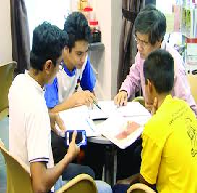Communication of Interethnic Service Encounters “Service Encounters” project is modeled on Bailey’s research presented in his paper, “Communication of Respect in Interethnic Service Encounters,” (Chapter 46, Blum reader). Re-read Bailey’s paper before starting the project.

Maximum credit available for the first draft is 50 points. Any points over 50 points allowed for the first draft will be credited as bonus points. Maximum credit available for the final draft is 60 points. In order to be graded, the paper needs to be edited for clarity and grammatical and typographic errors. Communication of Interethnic Service Encounters Plan on consulting the Writing Center to get five bonus points !!! Even best writing can be improved. Set up an appointment to work individually with a tutor at the North or South Student Learning Center
The project involves following steps:
Conduct careful observation of “service encounter” type of interactions in a real world setting
Select a setting such as convenience store, cafeteria or Starbucks, open to the public. Communication of Interethnic Service Encounters Select time when there is not much traffic so that people are not too rushed. Observe and describe in your notes four interactions between the attendant and customer. At least three of the conversations should involve either the customer or the service person introducing a topic not directly related to the business transaction at hand, such as in these hypothetical exchanges:
EXAMPLE I
Attendant: Will that be it?
Customer: Yeah. I haven’t seen you for a while?
Attendant: Would you like any cash back?
Customer: Nope.
Attendant: Thanks for shopping at Walgreens
EXAMPLE II
Attendant: Will that be it?
Customer: Yeah. I haven’t seen you for a while?
Attendant: I know, I went to see my boyfriend in Hawaii
Customer: That’s great. Good to have you back, though
Attendant: I’m glad to be back, too. Would you like any cash back?
Customer: Nope.
Attendant: Thanks for shopping at Walgreens
Take detailed notes of your observation.
Like in Bailey’s research, your most important data will be your conversation data. Write down in as much detail as you can the exact words that people use in talking to each other. Also, describe people participating in the conversation (age, gender, anything else you notice)
Conduct Conversation Analysis
Your analysis will address conversational uptakes on topics not directly related to the business transaction and introduced in the service encounter interactions data from your research. Communication of Interethnic Service Encounters
Communication of Interethnic Service Encounters Uptake
a follow up on the topic introduced by another person. An uptake is a conversational tool that helps to create conversation as a collaborative project. In doing so, it mainly serves a phatic communicative function; that is, the maintenance of social relationship between people who participate in communicative event. Communication of Interethnic Service Encounters
To illustrate: in the EXAMPLE I above, the attendant did not offer an uptake on the customer’s inquiry, “I haven’t seen you for a while?” in line 2. In contrast, in the EXAMPLE II, the attendant did offer an uptake in line 3, by saying “I know, I went to see my boyfriend in Hawaii,” followed by the customer’s uptake, “That’s great. Good to have you back, though” (line 4) and further, by the attendant’s next uptake, “I’m glad to be back, too.”
In the analysis of your conversational data, identify statements that invite an uptake and assess whether an uptake has taken place. Communication of Interethnic Service Encounters
write a paper about 3 pages long (12-–-point font, double-–-spaced) in which you will:
describe where and when you conducted your observation
describe three or four service encounters, following the format of the examples above. Include your notes on the conversations and describe persons who articipated in the interaction (age, gender, ppearance, etc.)
present your analysis of your conversational data in which you will identify:
utterances (statements, questions, etc.) that invite an uptake and either the presence or an absence of uptake.
based on Bailey’s work, suggest some of the possible reasons for a person not to offer an uptake. Communication of Interethnic Service Encounters




